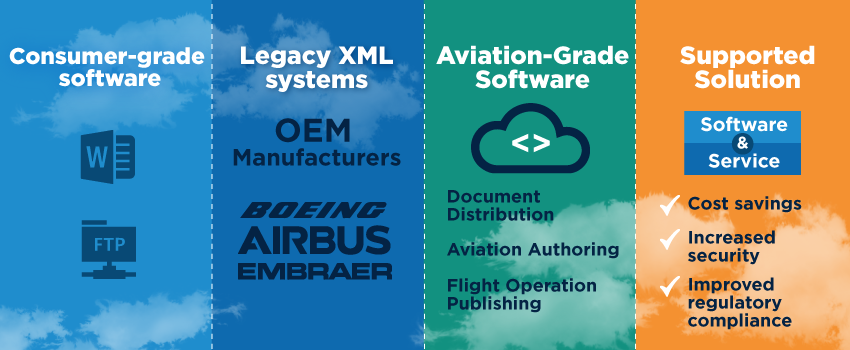

Airlines have specific requirements when it comes to their mission-critical documents and manuals - and that means needing the right type of document management process and system in place to help them achieve that. Some airlines still opt for paper processes, but as more organisations are going digital, paper poses some obvious drawbacks such as:
As a result of this, airlines are now looking to upgrade their processes and look for an approach to document management that supports a digital process. There are many different types of document management technology available to support an airline's document management approach. Read the article to learn four approaches to airline document management and what they can offer in terms of functionality and benefits.
When iPad and EFB technology began being introduced to the airline industry, it was a nudge for organisations to start digitising their cockpits. However, with a lack of software to support this change, airlines relied on consumer-grade software such as word processing software and viewers - neither of which were developed with airlines in mind. Additionally, they would also require using FTP protocols to distribute PDFs.
Even today, there are still some organisations that are using this type of software to manage their documents, even with other options on the market. The problem with using software such as this, for a complex environment, is that it’s not compliant, there’s a lack of user experience and a lack of control over the distribution and tracking of manuals.
Legacy XML systems do offer multiple benefits, especially for pilots. These include being able to administer scope search and the ability for incremental updates and downloads. However, as with most legacy systems, XML editing tools means there is a big learning curve for editors and often poor user experience involved - meaning that you would always need to invest in training employees to use it effectively. Legacy XML tools often provide some benefits to one user group in priority to another, so publishers may find value in having access to the XML file but its translation into a viewer may not benefit the end-user, the flight crew.
Additionally, these types of systems are generally designed from the bottom up and support the OEM manufacturers first and foremost with airline end users having to develop an approach to support the information they provide. On top of that, you often need to consider purchasing another system that can handle the revisions and distributions.
Aviation-grade systems, as their name suggests, specifically addresses issues that challenge aviation professionals when it comes to document management. These systems can be deployed in both small and large organisations in order to provide scalability and resource solution. Such enterprise-grade systems can be handy if you have thousands of users across multiple locations. These systems are often cloud native and include the following aspects within it:
Document Distribution
Aviation Authoring
Flight Operation Manual Authoring
A supported solution is a hybrid system which allows airlines to gain the best of both worlds for the management of their documents. A supported solution works on the basis of specially designed, aviation-grade software.
This software includes the features and functionality that can support an airline’s document management process - but also includes access to a team of airline manual editing experts (XML, PDF, etc.) who can support the management, editing and publication of all OEM manuals. This approach offers a multitude of benefits including:
Knowing which document management system is the right one for your airline is a vital aspect for your operations, with your choice ultimately based on the requirements of your organisation. However, you want to be able to choose a system that not only helps you manage, publish and distribute your mission-critical manuals and documents, but overall helps your airline remain compliant, safe and efficient.
With so many different options available on the market, it can be difficult to make the right decision. We’ve written a useful guide on learning how to select the right system that benefits your airline by making sure that you take all considerations into account.
Download the free 'Aviation Document Management System Selection Guide' today to learn more.
Vistair’s First Hackathon - Cultivating Co-creation and Innovation
Vistair Expands Team in North America
Jet2 signs new DocuNet contract
Vistair attends the Airline & Aerospace MRO and Flight Operations IT Conference - Americas 2019
How Safety Performance Indicators Help Airlines Improve Their Safety Management System